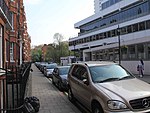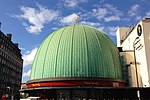Westminster Law School
Education in LondonLaw schools in EnglandLondon stubsProfessional education in LondonUnited Kingdom education stubs ... and 2 more
University of WestminsterUse British English from November 2019
Westminster Law School (WLS) is the law school of the University of Westminster. Located at Little Titchfield Street near Regent Street in central London. It awards LLB, LLM and PhD degrees, and also provides professional legal education including the Graduate Diploma in Law conversion course, the Legal Practice Course, for intending solicitors, and the Bar Professional Training Course for intending barristers.
Excerpt from the Wikipedia article Westminster Law School (License: CC BY-SA 3.0, Authors).Westminster Law School
Marylebone Road, London Marylebone
Geographical coordinates (GPS) Address Nearby Places Show on map
Geographical coordinates (GPS)
| Latitude | Longitude |
|---|---|
| N 51.522 ° | E -0.1549 ° |
Address
University of Westminster, Marylebone Campus
Marylebone Road 35
NW1 5LR London, Marylebone
England, United Kingdom
Open on Google Maps











